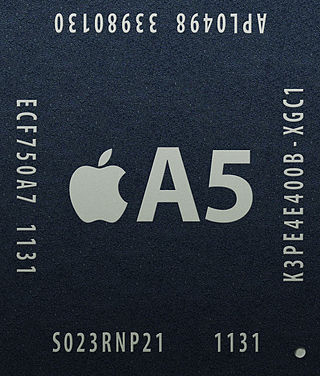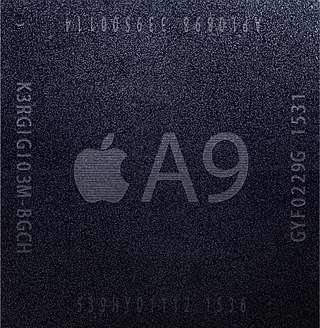XScale is a microarchitecture for central processing units initially designed by Intel implementing the ARM architecture instruction set. XScale comprises several distinct families: IXP, IXC, IOP, PXA and CE, with some later models designed as system-on-a-chip (SoC). Intel sold the PXA family to Marvell Technology Group in June 2006. Marvell then extended the brand to include processors with other microarchitectures, like Arm's Cortex.

OMAP is a family of image/video processors that was developed by Texas Instruments. They are proprietary system on chips (SoCs) for portable and mobile multimedia applications. OMAP devices generally include a general-purpose ARM architecture processor core plus one or more specialized co-processors. Earlier OMAP variants commonly featured a variant of the Texas Instruments TMS320 series digital signal processor.
PowerVR is a division of Imagination Technologies that develops hardware and software for 2D and 3D rendering, and for video encoding, decoding, associated image processing and DirectX, OpenGL ES, OpenVG, and OpenCL acceleration. PowerVR also develops AI accelerators called Neural Network Accelerator (NNA).
The transistor count is the number of transistors in an electronic device. It is the most common measure of integrated circuit complexity. The rate at which MOS transistor counts have increased generally follows Moore's law, which observes that transistor count doubles approximately every two years. However, being directly proportional to the area of a die, transistor count does not represent how advanced the corresponding manufacturing technology is. A better indication of this is transistor density which is the ratio of a semiconductor's transistor count to its die area.
Adreno is a series of graphics processing unit (GPU) semiconductor intellectual property cores developed by Qualcomm and used in many of their SoCs.

VideoCore is a series of low-power mobile multimedia processors originally developed by Alphamosaic Ltd and now owned by Broadcom. Alphamosaic marketed its first version as a two-dimensional DSP architecture that makes it flexible and efficient enough to decode a number of multimedia codecs in software while maintaining low power usage. The semiconductor intellectual property core has been found so far only on Broadcom SoCs.

Snapdragon is a suite of system-on-a-chip (SoC) semiconductor products for mobile devices designed and marketed by Qualcomm Technologies Inc. The Snapdragon's central processing unit (CPU) uses the ARM architecture. As such, Qualcomm often refers to the Snapdragon as a "mobile platform". Snapdragon semiconductors are embedded in devices of various systems, including vehicles, Android, Windows Phone and netbooks. In addition to the processors, the Snapdragon line includes modems, Wi-Fi chips and mobile charging products.

The iPhone 3GS, stylised as iPhone 3G🅂 is a smartphone that was designed, developed, and marketed by Apple Inc. It is the third generation iPhone and the successor to the iPhone 3G. It was unveiled on June 8, 2009 at the WWDC 2009 which took place at the Moscone Center in San Francisco.

The Apple A4 is a 32-bit package on package (PoP) system on a chip (SoC) designed by Apple Inc., part of the Apple silicon series, and manufactured by Samsung. It was the first SoC Apple designed in-house. The first product to feature the A4 was the first-generation iPad, followed by the iPhone 4, fourth-generation iPod Touch, and second-generation Apple TV.
Rockchip is a Chinese fabless semiconductor company based in Fuzhou, Fujian province. Rockchip has been providing SoC products for tablets & PCs, streaming media TV boxes, AI audio & vision, IoT hardware since founded in 2001. It has offices in Shanghai, Beijing, Shenzhen, Hangzhou and Hong Kong. It designs system on a chip (SoC) products, using the ARM architecture licensed from ARM Holdings for the majority of its projects.

The Apple A5 is a 32-bit system on a chip (SoC) designed by Apple Inc., part of the Apple silicon series, and manufactured by Samsung. The first product Apple featured an A5 in was the iPad 2. Apple claimed during their media event on March 2, 2011, that the ARM Cortex-A9 central processing unit (CPU) in the A5 is up to two times faster than the CPU in the Apple A4, and the PowerVR SGX543MP2 graphics processing unit (GPU) in the A5 is up to nine times faster than the GPU in the A4. Apple also claimed that the A5 uses the same amount of power as the A4.

Apple silicon refers to a series of system on a chip (SoC) and system in a package (SiP) processors designed by Apple Inc., mainly using the ARM architecture. They are the basis of Mac, iPhone, iPad, Apple TV, Apple Watch, AirPods, AirTag, HomePod, and Apple Vision Pro devices.

The Samsung Exynos, formerly Hummingbird (Korean: 엑시노스), is a series of ARM-based system-on-chips developed by Samsung Electronics' System LSI division and manufactured by Samsung Foundry. It is a continuation of Samsung's earlier S3C, S5L and S5P line of SoCs.

The Apple A5X is a 32-bit system on a chip (SoC) designed by Apple Inc., part of the Apple silicon series, and manufactured by Samsung. It was introduced with and only used in the third-generation iPad, on March 7, 2012. The A5X is a high-performance variant of the Apple A5. Apple claimed the quad-core PowerVR SGX543MP4 graphics processing unit (GPU) in the A5X is two times faster than the GPU in the A5, as the A5X GPU contains two more cores than the dual-core version GPU in the A5.

The Apple A6X is a 32-bit system-on-a-chip (SoC) designed by Apple Inc., part of the Apple silicon series. It was introduced with and only used in the 4th generation iPad, on October 23, 2012. It is a high-performance variant of the Apple A6 and the last 32-bit chip Apple used on an iOS device before Apple switched to 64-bit. Apple claims the A6X has twice the CPU performance and up to twice the graphics performance of its predecessor, the Apple A5X. Software updates for the 4th generation iPad ended in 2019 with the release of iOS 10.3.4 for cellular models, thus ceasing support for this chip as it was discontinued with the release of iOS 11 in 2017.
The Apple A8 is a 64-bit ARM-based system on a chip (SoC) designed by Apple Inc., part of the Apple silicon series, It first appeared in the iPhone 6 and iPhone 6 Plus, which were introduced on September 9, 2014. Apple states that it has 25% more CPU performance and 50% more graphics performance while drawing only 50% of the power of its predecessor, the Apple A7. The latest software updates for the 1.1GHz and 1.4GHz variants systems using this chip are iOS 12.5.7, released on January 23, 2023 as they were discontinued with the release of iOS 13 in 2019, and 1.5 GHz variant for the iPad Mini 4 is iPadOS 15.8.2, released on March 5, 2024 as it was discontinued with the release of iPadOS 16 in 2022, while updates for the 1.5 GHz variant continue for Apple TV HD. The A8 chip was discontinued on October 18, 2022, following the discontinuation of the Apple TV HD.

The Apple A9 is a 64-bit ARM-based system-on-chip (SoC)designed by Apple Inc., part of the Apple silicon series. Manufactured for Apple by both TSMC and Samsung, it first appeared in the iPhone 6S and 6S Plus which were introduced on September 9, 2015. Apple states that it has 70% more CPU performance and 90% more graphics performance compared to its predecessor, the Apple A8. On September 12, 2018, the iPhone 6S and iPhone 6S Plus along with the first-generation iPhone SE was discontinued, ending production of A9 chips. The latest software updates for the iPhone 6S & 6S Plus including the iPhone SE 1st generation variants systems using this chip are iOS 15.8.2, released on March 5, 2024, as they were discontinued with the release of iOS 16 in 2022, and for the iPad 5th generation using this chip was iPadOS 16.7.6, also released on March 5, 2024, as it was discontinued with the release of iPadOS 17 in 2023.

The Apple A10 Fusion is a 64-bit ARM-based system on a chip (SoC) designed by Apple Inc., part of the Apple silicon series, and manufactured by TSMC. It first appeared in the iPhone 7 and 7 Plus which were introduced on September 7, 2016, and is used in the sixth generation iPad, seventh generation iPad, and seventh generation iPod Touch. The A10 is the first Apple-designed quad-core SoC, with two high-performance cores and two energy-efficient cores. Apple states that it has 40% greater CPU performance and 50% greater graphics performance compared to its predecessor, the Apple A9. The Apple T2 chip is based on the A10. On May 10, 2022, the iPod Touch 7th generation was discontinued, ending production of A10 Fusion chips. The latest software updates for the iPhone 7 & 7 Plus including the iPod Touch 7th generation variants systems using this chip are iOS 15.8.2, released on March 5, 2024, as they were discontinued with the release of iOS 16 in 2022, while updates for the iPad variants systems using this chip are still supported.













